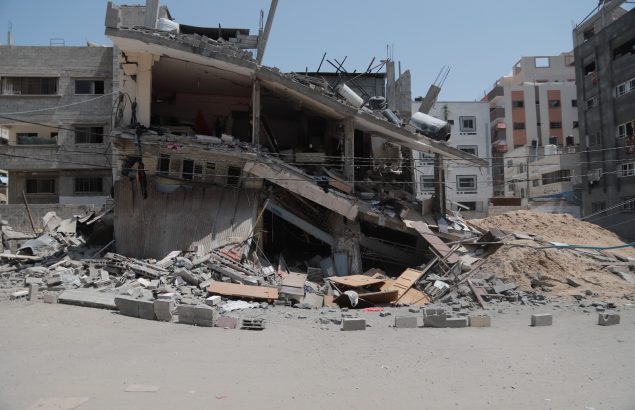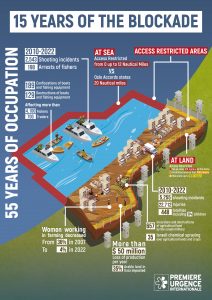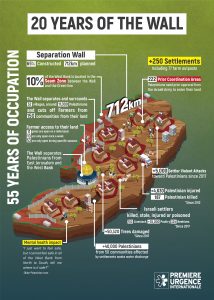INFOGRAPHICS: IN THE WEST BANK AND GAZA STRIP, THE POPULATION IS FACING THE 55TH YEAR OF ISRAELI OCCUPATION
For 55 years, the populations of the West Bank and Gaza Strip have been living under Israeli occupation and suffering one of the longest humanitarian and displacement crises in modern history. A look at the consequences of the occupation for the Palestinians in infographics.

Image of destruction caused by Israeli strikes in August 2022 in Gaza I © Première Urgence Internationale
The Gaza strip has now been under blockade for 15 years, counting number of bombing and indiscriminate targeting of civilians, infrastructures and livelihood. In the past years, not only Palestinians have suffered the consequences of heavy military escalations, but daily human rights violations are also taking place.
GAZA STRIP : BLOCUS AND RESTRICTIONS
In addition to the blockade of the Gaza strip, the Israeli authorities have unilaterally enforced access restricted areas at land and at sea. Those areas are the food basket of Gaza. At sea, depending on the political situation, fishers are allowed to go between 0 and 12 nautical miles, when the Oslo Accords stated that they could go up to 20 nautical miles. Even within the allowed areas, the Israeli army continues to shoot live ammunitions at fishers, arrest them from their boat and/or confiscate or destroy their boats and fishing gears. From 2010 to 2022, more than 4 000 fishers were affected by the Israeli actions. These human right and humanitarian violations have a detrimental effect for fishers and their families’ livelihood and on the economy of Gaza already collapsing due to the siege.
Gazans are also impacted by Israeli military practices at land, near the fence. While 35% of arable lands in Gaza are located near the fence, farmers are not allowed to enter the first 100 meters. Up to 300 metres to the fence, Palestinians can only access on foot and the situation remains dangerous within more than 1 km, with farmers being shot at while cultivating their land, Israeli chemical spraying on crops, levelling of land and floodings. More than 5000 shooting incidents happen between 2010 and July 2022 including during the Great March of Return, where Palestinians protested near the fence against the blockade. These practices undermine the access to livelihood and economic means to Gazans and create a protracted humanitarian crisis.

WEST BANK : A TERRITORY SURROUNDED BY A 712 KM WALL
The West Bank has now been closed for 20 years, by a 712km wall, surrounding and heavily affecting Palestinians and their access to livelihood. The wall does not follow the green line defined by the United Nations in 1967 (UNOCHA map), but was rather built by the Israeli authorities inside the West Bank separating Palestinian communities from each other. As a result, 10% of their land situated between the green line and the wall is almost inaccessible as access is rarely granted to Palestinians. Jerusalem was also sided out from the rest of the West Bank when it was annexed. Palestinian farmers are not able to freely access their land and properties on the other side of the wall and need to ask for specific permits that are often denied (Hamoked).
Occupation is not limited to the wall but also to heavy military presence and de facto annexation of part of the West Bank and forcible displacement of Palestinians. There are now in the West Bank more than 250 Israeli settlements that are illegal under international law, including at least 77 farm outposts that are also illegal under Israeli law. Settlements are usually built on hill tops stealing private owned land of Palestinians. The surrounding lands that are usually agricultural lands become almost inaccessible for Palestinians due to Israeli settler attacks and/or Israeli military presences. Some areas near settlements even need prior coordination for farmers to enter their lands.
The presence of Israeli settlements and civilians into occupied territory is prohibited under international law and creates a heavy coercive environment. Since 2017, UNOCHA has registered more than 5000 attacks of settlers against Palestinians and their properties. In those attacks 187 Palestinians lost their lives. Settlers destroy trees and attack livestock of Palestinians, giving Palestinian no choice but to move away and lose their means of income.
Settlements also heavily pollute Palestinian land by different means, such as discharging their waste water, affecting at lease more than 40,000 Palestinians their health and livelihood. These occupation practices violate basic human rights and keep prolonging the humanitarian protracted crisis.

The long military occupation and practices, illegal under international law, leave an entire population in need of humanitarian aid when all the resources, if accessible, would be sufficient for Palestinian to live well and in dignity.
